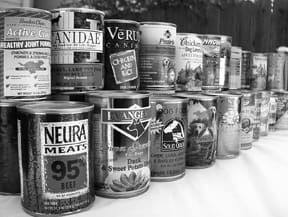When I was a kid growing up in the country, my family’s dogs ate a pelleted food that came in 50-pound burlap sacks from the same feed store where we purchased hay and grain. The food looked more like chicken feed than anything else, but our dogs cleaned it up.
Until I was about 12, the only canned pet food I ever saw was at my grandmother’s house. She lived with one of my uncles in the city, and fed my uncle’s fat orange cat a small can of food every day. As a tomboy used to romping barefoot around the countryside with a pack of dogs, I thought the city was unbearable, the cat spoiled, and the cat’s food repugnant. Surely only sissy cats and foo-foo dogs ate that stinky stuff!
As I grew into adulthood, I learned to feed my dogs dry foods that have steadily increased in quality. But I overcame my life-long bias against canned foods only a couple of years ago, when I found out that top-quality canned pet foods are actually quite healthy, perhaps more so than dry foods. They should never be dismissed as being a frou-frou luxury for spoiled pets, as I regarded them for decades.
Canned foods are frequently made with higher-quality ingredients than their dry counterparts, including fresh, whole meats, grains, and vegetables. They generally contain a higher percentage of meat than dry foods, if for no other reason than because dry food extruders can’t handle foods that contain more than 50 percent meat. Also, canned foods usually contain way fewer chemical additives than dry foods. Artificial colors and flavors are actually uncommon in canned products; because of the moist, fragrant nature of the meat-based contents, artificial flavoring and other palatants are rarely needed to attract dogs to otherwise unappealing food.
Of course, palatability is why the guardians of fussy old dogs and cats end up buying canned foods you don’t want older or sick animals skipping meals. But the higher palatability of canned foods also indicates that the food more closely resembles what dogs are hard-wired to enjoy, namely, meat! Dogs generally like canned food more than kibble because it tends to contain more meat and more fat than dry food.
Canned food also tends to have a higher energy content, ounce for ounce. Its high moisture content is helpful for dogs with cystitis or kidney disease. The high moisture content can also help a dog who is on a diet feel full faster.
In addition, added preservatives, which are ubiquitous in dry foods are unnecessary and rarely seen in canned foods, due to the sealed, oxygen-free environment that a can offers. (This does not mean the foods are free of preservatives altogether; some ingredients arrive at the food manufacturing plants already preserved. As long as the maker does not augment the food with additional preservatives, this hidden ingredient does not have to be declared on the food label.) Because they lack added preservatives, canned foods must be kept refrigerated after opening.
WDJ’s selection criteria
Of course, not all canned dog foods are full of fabulous, healthy ingredients. As with every other sector of the commercial food industry, there are lots and lots of subpar products on the market, and a small, select group of top-quality products.
Here’s how we determine which foods are which. We required the following for a product to make it into the running for our Top Canned Dog Foods:
We eliminated all foods containing artificial colors, flavors, or added preservatives.
We rejected any food containing meat by-products or poultry by-products. (Please note that in past years, we did select some foods that contained meat and poultry by-products. We don’t think by-products are necessarily bad; they just aren’t as good as muscle meat. In order to winnow down our list to the very best foods possible, we no longer include foods that contain meat or poultry by-products.)
We rejected any food containing fat or protein not identified by species. Animal fat is a euphemism for a low-quality, low-priced mix of fats of uncertain origin. Meat by-products can be from any mammal or mix of mammals. These ingredients come to the food makers at bargain-bucket prices, and accordingly, may not have been handled as carefully as more valuable commodities.
One borderline case: poultry fat. We’d prefer to see chicken fat, for example, than a mix of fats, potentially bought and mixed from various sources. But we have selected a couple of foods that contain poultry fat.
We eliminated any food containing sugar or any other sweetener. A food containing quality meats shouldn’t need additional palatants to entice dogs.
We looked for foods with whole meat, fish, or poultry as the first ingredient on the food labels. By law, ingredients are listed on the label by the total weight they contribute to the product. Water is necessary for the manufacturing process used to make canned foods, but in lower-quality products, water is usually the first ingredient. (Again, in past years, we selected some foods that featured water in the first position on the label; we are tightening up our list.) It’s not a requirement, but we like it when a nutritious meat, poultry, or fish broth is used in place of water.
We looked for the use of whole grains and vegetables, rather than a series of reconstituted parts, i.e., rice, rather than rice flour, rice bran, brewers rice, etc.
We award theoretical bonus points for foods that offer the date of manufacture (in addition to the usual best if used by date), nutrition information beyond the minimum required, and any organic ingredients. Expensive and hard to find
It may come as a shock to learn that the best foods for your dog the ones that contain only top-quality whole-food ingredients are both more expensive and more difficult to find than foods whose names you may be more familiar with. Just as with human foods, the dog foods that are produced and sold in the largest quantities in this country are not the healthiest foods.
This principle is also true of human foods, so it shouldn’t be a surprise. If you go to a large chain grocery store in search of processed foods that don’t contain numerous food fragments, preservatives, artificial colors, etc., you’ll soon discover these sorts of products are uncommon there. You might see 15 different types of macaroni and cheese mix on the shelf, but you probably won’t find even one that doesn’t contain artificial colors, flavors, and more than 30 ingredients unless you go to a health food store or a gourmet food store. In these small, independently owned and operated shops, you’ll find all sorts of foods that were manufactured without additives and fragments. In these stores, a box of macaroni and cheese mix might be $2.79 rather than $0.69, but it will contain just four or five healthy ingredients and taste great, too.
Not rank-ordered
Our Top Canned Food selections are listed alphabetically on the next page. We don’t rank-order our selections; all of the products listed on the chart meet our criteria for top-quality foods.
Please don’t regard the products on our list as the only good foods, or even as the best foods on the market. We don’t pretend to know about every food on the market. There are probably hundreds of foods available somewhere in the U.S. that we dont know about. Some of these may meet our selection criteria for a top-quality canned food; you can easily determine this for yourself by comparing the ingredients listed on the food with our selection criteria.
Which one is best for your dog? We can’t tell you that. Price or local availability influences some dog owners decisions. The most important criterion should be your dog’s response to the food. Keep an eye on his coat, eyes, ears, stool, mood, energy, appetite, and grooming habits. If he develops itchy paws, diarrhea, or goopy ears a week after changing foods, think about changing again. Note the ingredients in the brand and variety you tried, in case you begin to see a trend an intolerance of chicken, for example. But if his health improves after changing foods, you’re on the right track.
By the way, we don’t think any food should be your dog’s one and only diet for months and years. As we discussed in Variety Is the Spice of Life (WDJ June 2001), it’s a good idea to periodically switch foods. Manufacturers tend to use the same vitamin/mineral pre-mix and the same food ingredients for years and years, resulting in a product with a fairly constant nutrient content. If a dog eats the same food and nothing but that food for years and years the brand loyalty that manufacturers love to hear about any nutritional imbalances, excesses, or deficiencies present in the food can eventually affect your dog’s health.
Food allergies and intolerances can also develop in dogs who eat the same food for long periods. Changing from a chicken-based food to one that contains only beef to a fish-based food can help prevent the development of food allergies.
To reiterate: We equally like and approve of all of the foods listed among our selections, and any other foods that meet our selection criteria. But your dogs response to the food is the ultimate criterion.
To view WJD’s 2002 Canned Dog Food Review here.
Also With This Article
Click here to view “Which is the Best Type of Dog Food?
Click here to view “The Top 5 Things to Look For on a Commercial Dog Food Label”
-by Nancy Kerns






